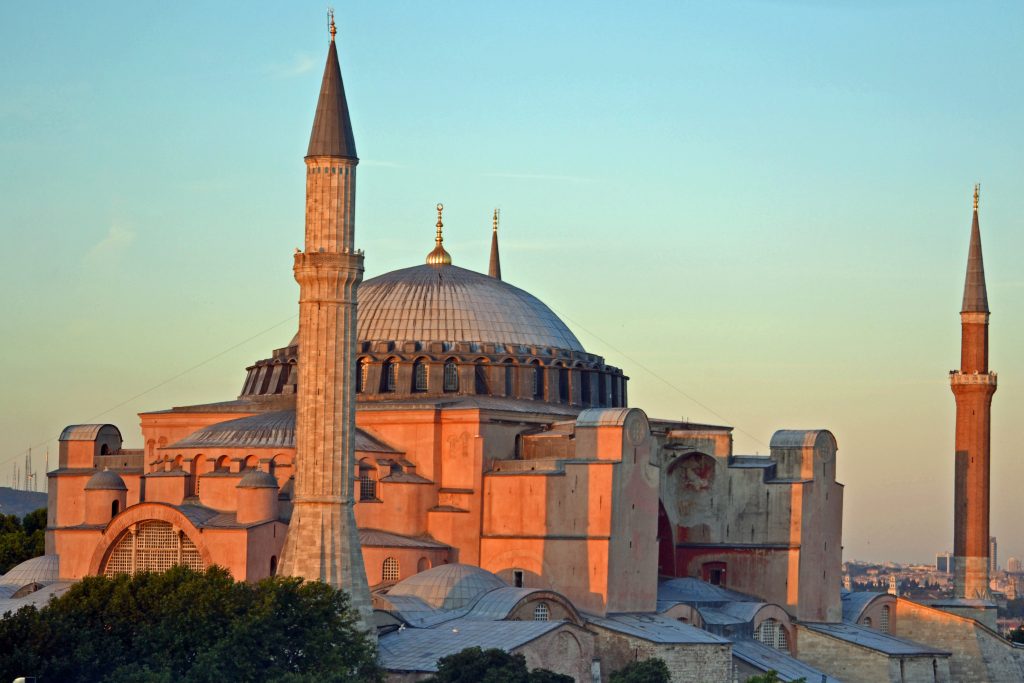The Hagia Sophia in Constantinople was the greatest cathedral in the Orthodox world — an architectural wonder built during the reign of St. Justinian, which, according to legend, inspired the emperor to declare, “Solomon, I have outdone thee.” Centuries later, Prince Vladimir of Kiev sent envoys to study Orthodoxy in Constantinople, and as the story goes, they came back and told him of their experience of liturgy in the Hagia Sophia, saying, “We knew not whether we were in heaven or on earth.”
Sadly, the Hagia Sophia is no longer a cathedral. After the Ottoman conquest of Constantinople in 1453, the great church was turned into a mosque. Then, in 1935, Ataturk — founder of the secular Republic of Turkey — converted the Hagia Sophia into a museum. It remains so today, although there have recently been calls from some quarters to make it a mosque again. Among Orthodox Christians, there have long been whispers and legends and prophecies about the Hagia Sophia one day being returned to the Church, and the Divine Liturgy once again being celebrated inside.
On July 12, 1952, the U.S. Ambassador to Turkey paid a visit to Ecumenical Patriarch Athenagoras at the Phanar. They had wide-ranging conversation covering all sorts of interesting topics, and I’ll publish the full text of the Ambassador’s confidential report soon. One of the most striking things Athenagoras told the Ambassador is that he was opposed to the idea of the Hagia Sophia being returned to the Orthodox Church:
The Patriarch expressed embarrassment at the recent actions of a Greek editor in demanding that the St. Sofia be returned to the Orthodox Church. He referred to an earlier statement of his own, which has recently been requested in connection with the article referred to, in which he had praised Ataturk for having made St. Sofia into a museum, a solution he considers very appropriate. He himself would not accept St. Sofia for the Church even if it were offered.
At first blush, it may be surprising to learn that Athenagoras would not accept the return of the great cathedral “even if it were offered.” Here, context is vitally important. While we may remember the Hagia Sophia as an Orthodox church, it was a mosque for nearly half a millennium after that, and it wasn’t made a museum until 1935 — just 17 years before Athenagoras’ statement. And it wasn’t just any mosque: the Hagia Sophia was the prototype mosque, the mosque upon which most other mosques around the world were — and are — modeled. Could it be, then, that — whatever his personal feelings — Patriarch Athenagoras told the U.S. Ambassador that he wouldn’t accept the Hagia Sophia back for the Church because he knew that this would likely lead to a violent backlash against the Church — the kind of violence that the Turkish mobs proved themselves capable of just three years later?

Typo. 1453 should read “after the conquest in 1053”
I’m not sure what you are referring to. I was talking about the Ottoman conquest of Constantinople in 1453.
You’re referring to the date Orthodox in the East separated themselves from the Catholic Church. That is not the year Constantinople fell.
Of course we Orthodox would characterize this as the Church of Rome separating herself from the rest of the Churches.
Interesting